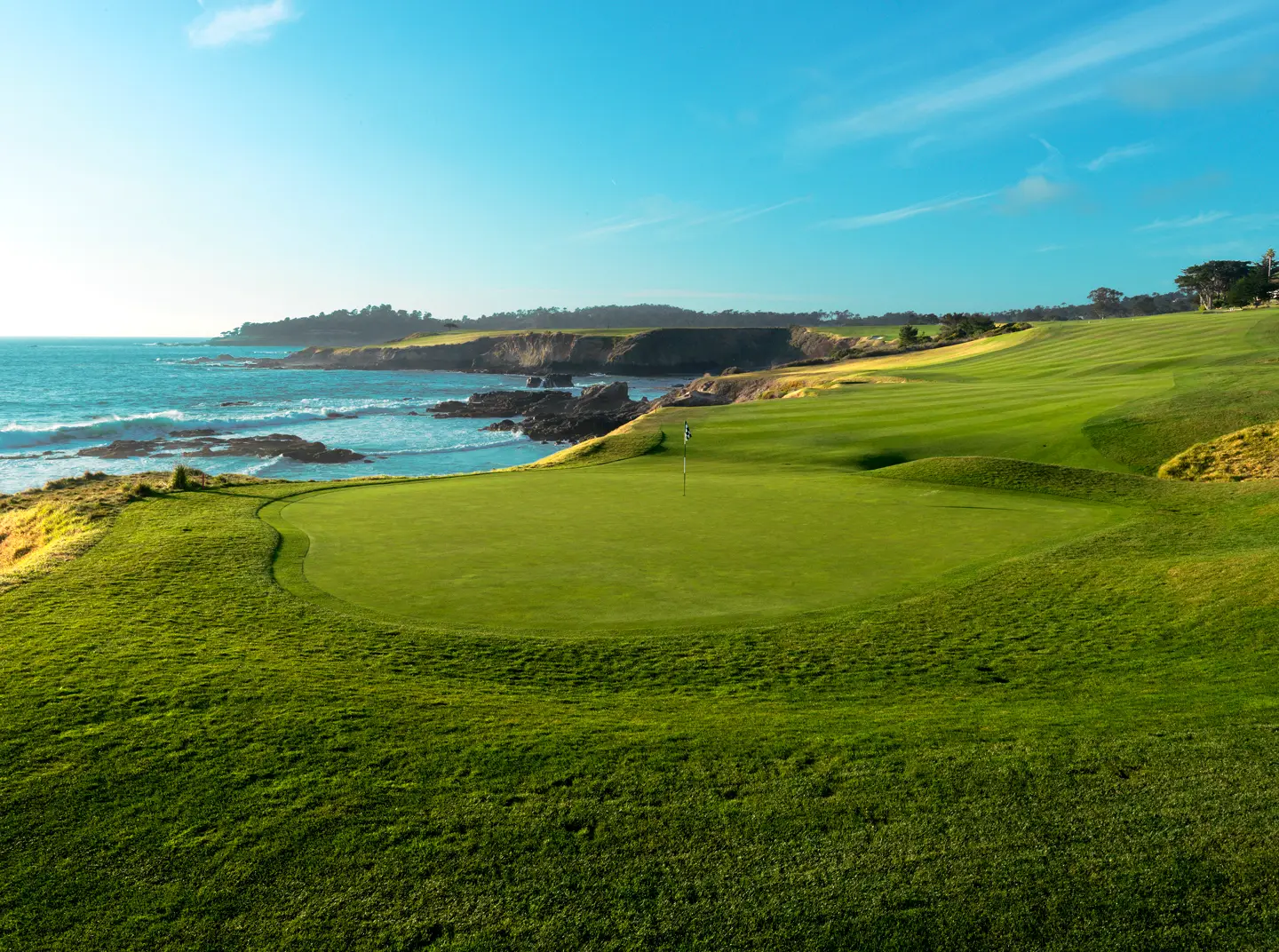The Mount Rushmore quartet that caused the least disagreement might well have been the original. The general feeling towards the selection of the four presidents on the South Dakota monument has certainly evolved over the decades but, at the time of its construction, it seems very few people had much of an argument with the choice of George Washington, Thomas Jefferson, Theodore Roosevelt, and Abraham Lincoln (not forgetting the Native Lakota Sioux who were forcefully removed from the site, of course).
Arguing over the four best sitcoms, IPAs, or muscle cars, on the other hand, can bring out the Tasmanian Devil in people. As long as it doesn’t cause tears, we’re all for a little light-hearted discord, and expect nothing less from our choice of the Mount Rushmore of seaside golf courses.
That said, it’s difficult to see many being too affronted by my chosen four. Some will have their favorites which, they believe, deserve a spot, but it’s important to remember the four here aren’t necessarily my four favorites but those I think are the greatest seaside courses (genuine links, clifftop, etc.) in the world and which have had the greatest impact on the game.
The Old Course at St. Andrews—St. Andrews, Scotland
If, for some reason, you object to the Old Course at St. Andrews being on the Mount Rushmore of the world’s seaside golf courses, then it’s very likely we can’t be friends. It will prove so gluey a sticking point, we probably won’t see eye-to-eye on much. Defending the Old Course’s position here seems utterly absurd because it would surely be well over 90 percent of golfers’ first choice.
None of us are saying it’s the most beautiful course in the world, because it clearly isn’t. No one thinks it the best-routed. The person doesn’t exist that believes it’s the most sensible course on the planet and, if someone did, they might need psychological help. And no one, not one single person, thinks it’s remotely close to being ideally configured for hosting major championships.
It’s a non-sensical anachronism that no present-day architect would consider recreating.
And yet, the feeling of securing a tee time on the Old Course is the same feeling a 5-year-old gets when opening their main present on Christmas Day or like opening that email from the admissions counselor at the university you so want to go to and the first word you see is “Congratulations.” It’s a memorable moment, and you’re not entirely responsible for your reaction.

Its history makes the Old Course so special. It gave the world the 18-hole standard. It’s located in the town from where The Royal and Ancient Golf Club governs the sport (along with the USGA). It’s the course/place that gave us Allan Robertson; Old and Young Tom Morris; Bobby Jones being held aloft by an adoring crowd; Jack Nicklaus taking off his yellow sweater before driving through the 18th green; and an arm-thrusting Seve Ballesteros celebrating a famous victory. And no one complains about it calling itself “The Home of Golf” because…well, it is.
But it’s more than that. For all its quirks and idiosyncrasies, the Old Course is perhaps the course that asks you more questions, gives you more options, and requires a more effective combination of strategy and execution than anywhere else.
Your first visit might come on a windless, sunny day when you finish five below your handicap and wonder what all the fuss is about. You come a second time and it’s blowing 20 mph, the sky is grey, and suddenly everything that worked last time hopelessly eludes you. You think it can’t be the same place. You come five more times and see conditions and contours you never saw before, and discover you’ve fallen for it even though you’ll never understand why.
And whether they know it or not, every golf course architect that ever lived has been heavily influenced by the Old Course.
Pebble Beach Golf Links—Pebble Beach, Calif.
Considering how many great ones there are, it’s hard to imagine a course with half a dozen or more so-so holes making it to a Mount Rushmore of seaside golf courses. But when the rest are very, very special and a trio so singularly peerless, so utterly without equal, it’s very hard to ignore. When so many important moments in the history of American golf…scratch that…golf have occurred there, its case becomes significantly more compelling. And when you realize that, for a significant slice of the population, it is one of the two golf courses in America they could name and see how its tee sheet is full regardless of how much a round there costs, it dawns on you that omitting it would make the list seriously flawed.

Pebble Beach was something special from its earliest days in 1919 when Jack Neville and Douglas Grant designed the original layout, but it’s evolved into something considerably better over time thanks to Herbert Fowler’s transformation of the 18th hole; Alister MacKenzie and then Chandler Egan’s pre-1929 U.S. Amateur changes; and Jack Nicklaus’s redesign of the short par-three 5th. Clearly, it was just too great to leave out.
Cypress Point Club—Pebble Beach, Calif.
That two of our Mount Rushmore seaside golf courses lie within a couple of miles of each other says something about the design of the courses, obviously, but perhaps even more about the stretch of coastline on which they sit. The shore at Pebble Beach certainly has cliffs but is predominantly sandy, while the waterfront at Cypress Point, six minutes to the northwest, is rockier.
The course, which debuted at No. 1 in The LINKS 100, opened in 1928 and was designed by Alister MacKenzie and Robert Hunter who replaced Seth Raynor, the original choice of architect, following his untimely death two years before. MacKenzie took advantage of the situation, designing a course that club member and former USGA President Sandy Tatum was moved to call the “Sistine Chapel of Golf.”

“I do not expect anyone will ever have the opportunity of constructing another course like Cypress Point,” MacKenzie said, “as I do not suppose anywhere in the world there is such a glorious combination of rocky coast, sand dunes, pine woods, and cypress trees.”
The club’s history of hosting important events pales against that of its neighbor (just the 1981 Walker Cup, and it was part of the Bing Crosby Pro-Am/AT&T Pebble Beach Pro-Am from 1947–90) but the Walker Cup returns this September when TV viewers will hopefully* be able to get some idea of just how staggeringly beautiful Cypress Point is.
Royal County Down Golf Club—Newcastle, Northern Ireland
With the achingly lovely Mountains of Mourne to the southwest and its network of commanding sand dunes (certainly the grandest dunes among these four courses), Royal County Down pushes Cypress Point and Pebble Beach hard for the most eye-catching award. And you’ll probably find a fair few golfers fortunate to have played all four here who’ll tell you RCD has the highest number of great or nearly great holes, or rather the lowest number of holes that aren’t.
Cypress Point fans will surely take issue, especially with RCD’s number of blind shots, but the point remains—Royal County Down is beautiful, demanding, unfailingly interesting, and has some history, too, with the club dating back to 1889 and the first course being laid out by Old Tom Morris. His design didn’t last long, however, and was reworked and lengthened by club member George Combe who is largely responsible for today’s routing. Harry Colt was engaged in 1926 and made a few significant changes, most notably adding the exquisite par-three 4th and sending the tee shot at the par-four 9th over a massive dune, and Donald Steel redesigned the par-four 16th hole in 2005.

Its championship-hosting record isn’t quite that of Northern Ireland neighbor Royal Portrush which was founded (as the County Club) a year before Royal County Down and, in July, will stage its third Open Championship. But it does have two Senior British Opens, two Amateur Championships (British), eight British Ladies Amateur Championships, a Palmer Cup, Curtis Cup, Walker Cup, and four Irish Opens on its resume. So, it definitely belongs here.
Honorable mentions: National Golf Links of America, Shinnecock Hills (okay, no seaside holes, but…it’s close enough), Seminole, Fishers Island, Bandon Dunes, Pacific Dunes, Muirfield, Royal Dornoch, Royal Portrush, Portmarnock, Royal St. George’s, Royal Liverpool (any Open Championship rota course, really), Royal North Devon…
*At the time of writing, the USGA had yet to publish its broadcasting schedule.







Crail Golfing Society, Crail, Scotland. 36 holes…18 by Gil Hanse, 18 by Old Tom Morris. All 36 have views of the North Sea.
While playing the Old and New Courses, our bus driver stopped by Crail to show us seaside trailers he vacationed at while a child. The people staying and their children there came out and greeted us and we had a fine discussion. Thought thus bus driver (a retired Glasgow police officer) was going to tear-up. The Crail courses look like a blast to play (very non-commercial) and the clubhouse folks were very friendly too. Will play their on my next Scotland visit.
I’ve played all 4 !! He couldn’t be more correct !!
White Witch, Jamaica, lighthouse sound in OC, Maryland, Haig Point in South Carolina
Pebble must be the most overrated course in the world. Five great holes and 13 mediocre ones!
What about Old Head in Kinsale in the Southwest of Ireland? Not yet with the history but just wait!!
Old Head
Ballybunion and Turnberry can’t be ignored and yes historyand the Road Hole is the only thing that keeps the Old Course on the mountain
Cyprus Point may be great but it is not open to the public to play. It would be like having one of the faces of Mt. Rushmore hidden behind another mountain. Very few are able to appreciate it.